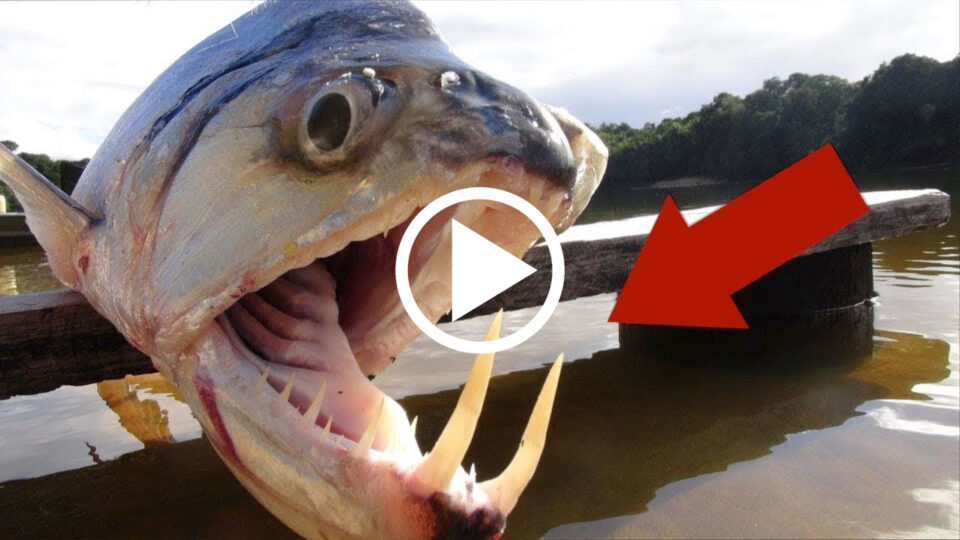There are many dangerous predators in our oceans and we’re very familiar with many of them such as the great white shark and the Barracuda.
But what about our rivers? What lurks at the bottom of rivers? Trust me, you’ll want to see this because many of these creatures could star in their own horror flick.
Today we countdown 15 terrifying animals found in rivers. Get your fishing gear ready and let’s dive in. Really?
Payara fish Number 15 on our list is the Payara fish. The payara is a carnivorous fish. Payaras are known by many names such as vampire fish or Dracula fish. The vampire fish makes its home in the Amazon basin of South America.
It likes clear, fast-moving water with lots of currents. You’ll often find it in churning rivers and the bottoms of waterfalls.
The Payara’s teeth are probably the first things that one notices about the Payara! Besides the sharp, spiky daggers that line their gums, Payaras have two elongated fangs that rise from their lower jaws.
These fangs can extend a whopping 4–6 inches, and they’re so big that Payaras are born with holes in their upper jaws that can house them. As for the rest of their build, they’re streamlined for power and speed.
They have fan-shaped caudal fins that help them swim in choppy currents and rapids, and bony faces which hide large gills.
Color-wise, vampire fish are almost always a silver or silver-gray with darker hints around their fins and tails. These darker markings can be the only way to tell them apart from other members of their genus.
Payaras can get large. They measure anywhere from 2 to 3 feet long, and their weight is around 10–35 pounds.
The largest one on record came in at 40 lbs. In the wild, Payaras are ferocious, hunters are constantly on the prowl for their next meal, and they don’t let anything impede dinnertime.
They’ve been known to chase off medium- and large-sized fish they don’t want to eat just so the water will be clear for the fish they do want to consume.
They’ll defend themselves if they’re caught on a line by a fisherman, and plenty of people have reported cuts, nips and bites, but they aren’t predatory towards humans.
Congo (Goliath) Tiger Fish Number 14 on our list is the Congo Goliath Tiger Fish.
The Goliath Tiger Fish is a large predatory fish that lives in the Congo River in Africa, with the largest specimens reaching a length of 6 feet, and a weight of 100 lbs.
This fish has long crocodile-like teeth, specially designed to tear chunks of meat out of other fish. The goliath tiger fish is a piscivore, which means it eats mainly fish.
With such impressive size an adult goliath tiger fish will eat any other fish that it can overpower, such as a small Nile perch.
When your name is Goliath, you’d better be one humongous, ferocious creature, and the Goliath tiger fish lives up to its moniker outclassing other African game fish in speed and power.
Locals say it’s the only fish that doesn’t fear the crocodile and eats smaller ones. We have also known it to attack humans in rare instances.
It’s so lightning quick and forceful that not only will it snap an angler’s line, but it will sometimes make off with his or her tackle.
No wonder one fishing safari promoter requires clients to read a cautionary treatise on the Goliath before agreeing to a fishing trip. Where is David and his slingshot when you need him?
Sawfish Number 13 on our list is the Sawfish. Despite their shark-like form and manner of swimming, they are rays.
These large- to huge-sized rays are characterized as having an elongated blade-like snout that has laterally placed tooth-like denticles set into sockets.
Sawfish inhabit all coastal tropical and subtropical waters, including estuaries and river systems.
Sawfish developed from extinct primitive sharks. They are some of the largest rays living today. The large-bodied species, which include the small-tooth, large tooth and green sawfish, commonly reach 16.4 feet.
We believe the maximum length of a sawfish to be 24 feet. The rostrum, often referred to as the “saw”, is used during feeding and for defense.
It slashes its saw in a side-to-side motion to dislodge invertebrates from the substrate and to stun schooling fishes.
In addition, the sawfish can use its saw in defense against large predators such as sharks. Humans are too large to be viewed as potential prey.
Care must be taken when handling or approaching a sawfish of any size, as they may defend themselves when they feel threatened, using their rostrum to strike from side-to-side with considerable force.
Sounds like the aquatic version of the “Texas Chainsaw Massacre”!


